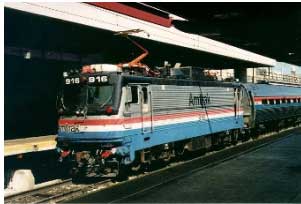Train travel – there is nothing else on Earth quite like it! I experienced such beginning at an early age, at either 11 or 12, more than likely 11, traveling on the then Pennsylvania Railroad between my at-the-time hometown of Baltimore, Maryland and New York City in 1964 or 1965, more than likely 1964, to attend the World’s Fair, joined by my mom and dad.
There isn’t much about this trip I even recollect other than the fact that somewhere between these two end-points or city pairs, the train I was riding broadsided a considerably smaller by comparison motor vehicle that had gotten stuck or for some reason was stopped on a railroad crossing, the occupants, most fortunately, having had the presence of mind to get out of the car and far enough away from the tracks so as not to place themselves in harm’s way at the moment the vehicle was struck. I remember sitting on the right side of the passenger car and by the time the train I was riding on had come to a stop, the impacted vehicle was in full view right outside my seat window. This occurred on the outbound trip as opposed to the inbound one. Though I can’t say for certain, my guess would be the car in question was declared a total loss.
Of course, that particular trip and other similar treks I had taken on the “Standard Railroad of the World” (as the Pennsy was once heralded as) was before Amtrak was even born. That did not come about until May 1, 1971. And, it took train travels on the National Railroad Passenger Corporation (Amtrak’s formal name) before I did ultimately gain a deep abiding respect and appreciation – and admiration – for traveling by train.
Amtrak’s importance as a passenger carrier cannot be overstated. It was created at a time when railroading in this country had, from a practical point of view, hit its lowest point, so much so that the private railroad companies which on many of the carriers passenger service had a long and proud tradition, wanted out of said business. For them, by the mid-to-late sixties and early seventies these were money-losing propositions.
But, there were more than just a handful chanting in unison, or so it might seem, “Not so fast!”. They (the movers and shakers) had other ideas, one, apparently to keep passenger train operations in the United States alive.
Enter a national network of passenger trains
On the first of May, nineteen-hundred-and-seventh-o
Ever since the first fledgling days, Amtrak in 50 years has come an extremely long way. Some of its more noteworthy accomplishments are creation of its partnerships with states, for example, with California with its state-run “Pacific Surfliner” (known previously as the “San Diegan” service), “Capitol Corridor” and “San Joaquin,” between San Luis Obispo and San Diego; Auburn and San Jose; and Bakersfield and Oakland/Bakersfield and Sacramento, respectively. Amtrak trains call on some 500 stations in the lower 48. An equipment (rolling stock) and infrastructure modernization program that is exemplary even with an annual “bare-bones” subsidy (“bare- bones” if you will compared to the considerable yearly highways cash infusion, that is) as well as the entity’s ability to consistently increase ridership on many of its routes, which speaks volumes!
Additionally, the National Railroad Passenger Corporation provides a viable and welcome alternative to more popular means of travel, namely, aviation and motoring, and in the case of the former between Boston and D.C., Amtrak offers a competitive option with its NEC-based “Acela Express” services. In certain instances, Amtrak serves places that planes simply do not, making this type of travel very practical and convenient.
No regrets
It was 50 years ago that the ultimate decision to keep passenger train service in America intact, was handed down. The journey along the way has not been without some difficult and trying moments, like the times when attempts were made to try to zero out Amtrak’s annual subsidy, to get it off the government dole, in other words, though those efforts, as it turns out, proved unsuccessful.
All of which is a testament to the importance and to some degree the necessity of the role Amtrak plays to the American – and to a very limited extent Canadian – people.
The real value in this company, as I see it, is that over Amtrak’s tenure millions upon millions of trips have been made on its trains in the ensuing years since the endeavor’s creation. Not hundreds, not thousands, not tens or hundreds of thousands, but millions.
So, who, I ask, could – or would even dare – scoff at that?! Something to think about as the latest infrastructure plan, proposal of the Biden Administration is being unveiled.
– Alan Kandel
All material copyright 2021


